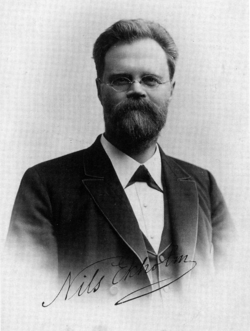Nils Gustaf Ekholm
Nils Gustaf Ekholm (9 October 1848 – 5 April 1923) was a Swedish meteorologist who led a Swedish geophysical expedition to Spitsbergen in 1882–1883.[1]

Biography
Ekholm was born in Smedjebacken in Dalarna, son of a pharmacist. Having completed his mogenhetsexamen in 1868, he enrolled at the University of Uppsala in September 1869, and graduated with a Candidate of Philosophy degree in 1876, completing a Licentiate degree in 1887 and a Ph.D. in 1888. He was a student of Robert Rubenson and Hugo Hildebrand Hildebrandsson. [2]
He worked at the Meteorological department at Uppsala University from 1876 until 1881, and again, after returning from his Spitsbergen expedition, 1884–1890, and was docent of meteorology at the university 1888–1892. From 1890 he worked as an assistant at the Swedish Meteorological Institute in Stockholm (one of the predecessor institutions of the current Swedish Meteorological and Hydrological Institute, SMHI, now located in Norrköping). He became professor and head of the institute in 1913, retiring at the age of 70 in 1918.
Ekholm was originally responsible only for the meteorological research of Andrée's Arctic balloon expedition (1897-1998). Ekholm was made head of the expedition as a whole after his predecessor, Commander F. Malmberg, had become unable to participate because of illness. The projected 1896 launch of engineer and balloonist S. A. Andrée balloon from Spitsbergen was called off because of contrary winds. Ekholm later started to question that the tightness of the balloon was going to be sufficient to keep hydrogen leakage to the minimum necessary for the success of the expedition. When Andrée disregarded his warnings, Ekholm abandoned the expedition. Ekholm was replaced by Knut Frænkel. Following the 1897 balloon launch, the entire expedition perished. [3] [4]
Ekholm is regarded as the founder of the Swedish storm warning system, which he initiated during his time at the Meteorological Institute. The system began in 1905 with 27 storm warning stations on the Swedish west coast, and expanded over the following years until it finally covered the entire Swedish coastline from 1913.[5]
Ekholm was elected a Fellow of the British Royal Meteorological Society in 1892, and a Member of the Royal Swedish Academy of Sciences in 1905.
In 1899, Ekholm, an early and eager spokesman for anthropogenic climatic control, pointed out that at present rates, the burning of coal eventually could double the concentration of atmospheric CO2. According to Ekholm, being influenced by the thoughts of his lifelong friend and colleague Svante Arrhenius, this would "undoubtedly cause a very obvious rise of the mean temperature of the Earth." By controlling the production and consumption of CO2, he thought humans would be able to "regulate the future climate of the Earth and consequently prevent the arrival of a new ice age (Fleming 1998).
Publications
Nils Ekholm, “On the variations of the climate of the geological and historical past and their causes.” Quarterly Journal of the Royal Meteorological Society, Jan. 1901 https://medium.com/@climatebrad/climate-hearings-af27a3886a43
Notes
- The biography is based on Anders Ångström, "Ekholm, Nils Gustaf", in Svenskt biografiskt lexikon, vol. 12 (1949), pp. 720–725.
- Anders Ångström. "Nils Gustaf Ekholm". Svenskt biografiskt lexikon. Retrieved April 1, 2019.
- "Salomon A. Andree 1896 Polar Expedition Collection, 1896". Smithsonian Institution. Retrieved April 1, 2019.
- Anders Ångström. "Knut H F Frænkel". Svenskt biografiskt lexikon. Retrieved April 1, 2019.
- Timeline of SMHI history Archived 2005-03-07 at the Wayback Machine
References
- Ångström, Anders: "Ekholm, Nils Gustaf", in Svenskt biografiskt lexikon, vol. 12 (1949), p. 720–725.
- "SMHI och dess föregångare i årtal fr o m 1873", a timeline of the history of SMHI and its predecessor institutions